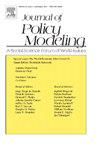The impact of the Federal Government debt on macroeconomic stability in the United States
IF 3.1
2区 经济学
Q1 ECONOMICS
引用次数: 0
Abstract
This study determines the public debt-to-GDP levels for the United States to identify debt thresholds that support macroeconomic stability, with a focus on price stability and low unemployment. Unlike previous studies that analyze how debt impacts economic growth, this research looks at how inflation and unemployment react to the rising debt ratio at different levels of debt. The analysis starts by estimating the relationship between changes in public debt and changes in real GDP, noting a significant shift in 2008Q1 coinciding with the onset of the global financial crisis. Prior to the crisis, debt increases had no impact on GDP, but afterwards, an inverse relationship emerged. The analysis then proceeds with the sequence of two tests. Firstly, by conducting SETAR(2,p) testing on quarterly data from 1996 to 2024, two debt ratio thresholds are identified at 55.75 % and 97.12 %. This categorizes the debt ratio in three zones: a low debt zone below the lower threshold, a high zone above the upper threshold, and an intermediate zone in between. The tests examine the debt ratio in relation to changes in the core PCE annualized inflation, the rate of unemployment and the federal funds effective rate as a non-switching regressor. Subsequently, cointegration and VECM(2,5) tests are conducted to examine interactions and determine impulse responses between the debt ratio, inflation and unemployment in each debt zone. Findings indicate that increases in the debt ratio do not impact inflation or unemployment in the low debt zone. In the intermediate zone, rising debt leads to an increase in unemployment. Conversely, in the high debt zone, both inflation and unemployment increase significantly with rising debt. These non-linear and reverse causal relationships suggest that the current high public debt in the US is detrimental to macroeconomic stability, highlighting the need for urgent policies to reduce the debt burden.
联邦政府债务对美国宏观经济稳定的影响
本研究确定了美国的公共债务占gdp的比例,以确定支持宏观经济稳定的债务门槛,重点是价格稳定和低失业率。与以往分析债务如何影响经济增长的研究不同,这项研究着眼于通胀和失业对不同债务水平下债务比率上升的反应。分析首先估算了公共债务变化与实际GDP变化之间的关系,并指出2008年第一季度与全球金融危机爆发同时发生了重大变化。在危机之前,债务增加对GDP没有影响,但在危机之后,一种反向关系出现了。然后按照两个测试的顺序进行分析。首先,通过对1996 - 2024年季度数据进行SETAR(2,p)检验,确定了55.75%和97.12%的两个负债率阈值。这将负债率分为三个区域:低于下限的低债务区域,高于上限的高债务区域,以及介于两者之间的中间区域。这些测试考察了债务比率与核心个人消费支出年化通胀率、失业率和联邦基金有效利率(作为非转换回归因子)变化的关系。随后,进行协整和VECM(2,5)检验,以检验每个债务区的负债率、通货膨胀和失业率之间的相互作用,并确定三者之间的脉冲响应。研究结果表明,债务比率的增加不会影响低债务地区的通货膨胀或失业率。在中间区域,不断上升的债务导致失业率上升。相反,在高债务地区,通胀和失业率都随着债务的增加而显著上升。这些非线性和反向的因果关系表明,美国目前高企的公共债务不利于宏观经济稳定,这凸显了采取紧急政策减轻债务负担的必要性。
本文章由计算机程序翻译,如有差异,请以英文原文为准。
求助全文
约1分钟内获得全文
求助全文
来源期刊

Journal of Policy Modeling
ECONOMICS-
CiteScore
6.20
自引率
11.40%
发文量
76
期刊介绍:
The Journal of Policy Modeling is published by Elsevier for the Society for Policy Modeling to provide a forum for analysis and debate concerning international policy issues. The journal addresses questions of critical import to the world community as a whole, and it focuses upon the economic, social, and political interdependencies between national and regional systems. This implies concern with international policies for the promotion of a better life for all human beings and, therefore, concentrates on improved methodological underpinnings for dealing with these problems.
 求助内容:
求助内容: 应助结果提醒方式:
应助结果提醒方式:


